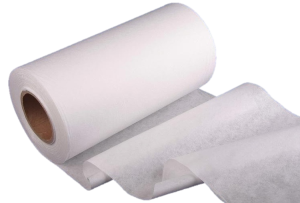1. What is the nonwoven fabric?
Nonwoven fabric represents a revolutionary category of engineered textiles distinct from traditional woven or knitted materials. Unlike conventional fabrics formed by interlacing yarns, nonwovens are made by directly bonding fibers or filaments together. The American Society for Testing and Materials (ASTM) first defined them in 1962 as “textile fabrics made of carded web or fiber web held together by adhesives.” Today, INDA, the Association of the Nonwoven Fabrics Industry, provides the authoritative definition: nonwoven fabrics are “sheet or web structures bonded together by entangling fiber or filaments mechanically, thermally, or chemically. They are flat, porous sheets made directly from separate fibers or molten plastic/plastic film, bypassing weaving, knitting, or yarn conversion entirely.”
2. How can you tell if a fabric is non-woven?
Nonwovens bring unique advantages across numerous applications due to their efficient manufacturing process. Woven fabrics feature interlocking warp and weft threads at right angles, creating characteristically strong, durable materials that tend to be less flexible. Knitted fabrics are produced through interlooping yarns, resulting in highly stretchable materials that move comfortably with the body, though they may lose shape over time. In contrast, nonwoven fabrics are typically lighter and weaker than their woven or knit counterparts. They exhibit limited elasticity (“memory”)—permanent “puckers may form after bending—and offer reduced laundering durability, making many suitable for disposable applications rather than durable apparel. Visually, look for a uniform sheet-like appearance lacking distinct yarn patterns.
3. Is cotton a non-woven fabric?
Nonwoven cotton fabric is widely known as a key nonwoven ingredient, but its properties make it ideal for a range of nonwoven products. With growing concerns about the environmental impact of synthetic fibers, cotton offers a flushable, compostable and comfortable alternative to man-made fibers. The innate absorbency and hypoallergenic characteristics of cotton make it an efficacious and comfortable alternative, as well.
Cotton is by its very nature a performance fiber. Its structure allows for superior absorption and release capabilities, making it a viable delivery system for cleansers, moisturizers, or efficacious formulations found in baby, personal care, and hygiene products. Another unique attribute of cotton is its superior wet strength. Cotton is naturally stronger when wet than dry lending enhanced tear resistance to all wet wipes even those used for tough household cleaning jobs. This trait makes cotton an ideal component for any nonwoven product that requires exposure to water or other liquids.
4. What are examples of non-woven fabrics?
Manufacturing techniques determine nonwoven characteristics, creating major categories: Airlaid nonwovens use air to deposit short fibers (like wood pulp), creating highly absorbent webs ideal for incorporating superabsorbent polymers. Thermal bonding (air through) employs heated air pulled through webs to melt thermoplastic binders, producing soft bulky fabrics. Meltblown nonwovens extrude polymers through micro-nozzles with hot air, creating ultra-fine fiber webs essential for filtration applications but with lower inherent strength. Spunlace (hydroentanglement) technology bonds fabrics using high-pressure water jets to entangle fibers mechanically, creating soft, strong cloth-like materials widely used in wipes and medical textiles (specialized nonwoven spunlace fabric manufacturers excel here). Spunbond (spunlaid) is a continuous process spinning filaments directly into bonded webs for strong, durable materials like geotextiles. SMS (Spunmelt) technology layers spunbond with meltblown to combine strength with fine barrier/filtration capabilities, critical for protective medical gear. Wetlaid nonwovens use a papermaking-like process suspending fibers in water to form uniform sheets for applications like teabags and battery separators.
5. Where are non-woven fabric used?
Due to its assortment of achievable characteristics nonwoven fabrics penetrate a wide range of markets including personal care, medical, apparel, automotive, filtration, construction, geotextiles, and protective. Winner Medical is one of the top nonwoven fabric supplier in China that provides all solutions for non-woven cotton items requests. And our Medical technology has already obtained patent certificates in the US, the EU, Indonesia and Malaysia, a totally of 30 countries around the world. Besides that, there are still a bunch of reasons to choose professional nonwoven fabric manufacturer Winner Medical, welcome to contact us.











